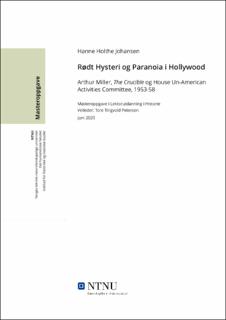| dc.contributor.advisor | Petersen, Tore Tingvold | |
| dc.contributor.author | Johansen, Hanne Holthe | |
| dc.date.accessioned | 2021-09-13T16:05:14Z | |
| dc.date.available | 2021-09-13T16:05:14Z | |
| dc.date.issued | 2020 | |
| dc.identifier | no.ntnu:inspera:59158535:22889682 | |
| dc.identifier.uri | https://hdl.handle.net/11250/2775602 | |
| dc.description.abstract | Denne oppgaven handler om House Un-American Activities Committee (HUAC) sine antikommunistiske høringer i Hollywood på 1950-tallet, og deres rettsforfølgelse og trakassering av flere hundre medlemmer av den amerikanske filmindustrien. En assosiasjon til det amerikanske kommunistpartiet førte til svartelisting og utestenging, som førte til ødelagt karriere og rykte. Oppgavens hovedeksempel er Arthur Miller, en anerkjent dramatiker, som ble stevnet for komiteen i 1956 og dømt til forakt for kongressen da han nektet å identifisere andre som var antatt å være kommunister. Millers opplevelser med komiteen var en parallell til hans eget skuespill, The Crucible, som sammenlignet hekseprosessene i Salem i 1692 med jakten etter kommunister på 1950-tallet. Til tross for at skuespillet var kritisk til sin samtid, og fikk mye kritikk for dette, var det ikke grunnen til at Miller ble stevnet foran komiteen. Miller var på dette tidspunktet i et forhold med filmstjernen Marilyn Monroe, og komiteen stevnet Miller for å få oppmerksomhet i pressen, ikke fordi hans liv eller verker var bevis for at han var kommunist. Siden komiteen ikke hadde faktiske bevis, brukte de uetiske metoder for å få han dømt for forakt for kongressen, en dom Miller senere anket og vant på basis av at metodene brukt mot han var urettmessige. Oppgaven bruker arkivmateriale hentet fra National Archives i Washington D.C. og Harry Ransom Center ved The University of Texas i Austin. Tilnærmingen vil være kvalitativ empirisk, hvor fokuset ligger på å analysere kildematerialets innhold og tolke diskursen. | |
| dc.description.abstract | The thesis details the House Un-American Activities Committee (HUAC) and their anti-communist hearings in Hollywood in the 1950s, which prosecuted and harassed several hundred members of the American film industry. An association with the American Communist Party ultimately led to blacklisting and exclusion, which ruined both a person’s career and reputation. The main example highlighted in the thesis is Arthur Miller, a renowned playwright, who testified before the committee in 1956 and was sentenced to contempt of Congress when he refused to identify others who were believed to be communists. Miller's experiences with the committee paralleled his own play, The Crucible, which compared the 1692 Salem witch trials to the hunt for communists in the 1950s. Although the play was critical of its time and received a lot of criticism, it was not the reason why Miller was brought before the committee. Miller was a relationship with movie star Marilyn Monroe, and the committee brought in Miller solely to garner attention from the press, not because his life or works were evidence that he was a communist. Since the committee had no actual evidence, they used unethical methods to get him sentenced to contempt of Congress, a verdict Miller later appealed and won on the basis that the methods used against him were unfair. The thesis uses archival material from the National Archives in Washington D.C. and Harry Ransom Center at The University of Texas at Austin. It uses a qualitative empirical approach, where the focus is analysing the content of the source material and interpreting the discourse. | |
| dc.language | | |
| dc.publisher | NTNU | |
| dc.title | Rødt Hysteri og Paranoia i Hollywood:
Arthur Miller, The Crucible og House Un-American Activities Committee, 1953-58 | |
| dc.type | Master thesis | |
